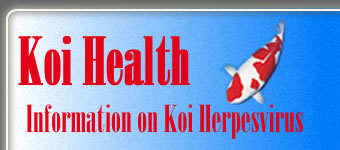
QUARANTINE
The primary purpose of quarantine is to protect one’s present collection from the introduction of disease and to determine whether or not the new additions are diseased. If disease is found to be present, it is isolated to the quarantine area for appropriate treatment. Quarantine allows for “watchful observation” of new additions and allows for fish recuperation in a non-stressful environment. Health problems can be addressed.
When bringing new fish into one’s establishment, they should first be isolated in a distinctly separate area from the other fish presently within the collection. There should be tank or pond systems where new koi can be housed. A quarantine system includes the individual tank(s) or pond(s) and their associated filtration system, pump, nets, feed container, and other equipment. All tanks or ponds serviced by common filtration or pumps compromise one quarantine system. If multiple quarantine systems are in the quarantine area, provision should be made to prevent splash contamination between systems by spacing or the use of splash guards. Each quarantine system should have its own equipment or means of disinfecting equipment between use in different systems within the quarantine area. Nets or other equipment should be hung or otherwise kept off the floor to avoid contact with potential infectious organisms on the floor.
The quarantine area should be in a separate room, building, or area that you can enter and leave without passing through the display collection, food service area, hospital/isolation tanks or the boarding facility. This helps prevent cross-contamination of microorganisms between areas. Traffic flow analysis is part of the aquaculture infectious disease management effort. The quarantine room or area should be the last one serviced each day. If the quarantine area is outside, provision should be made to protect the area from birds or other predators which might potentially spread disease.
The quarantine area should have its own set(s) of nets, equipment and testing supplies. A means of disinfecting potentially mucus laden nets or equipment should be available. An area for employee washing after working in the quarantine area is recommended. Antimicrobial foam hand cleaners may be utilized in the event a hand washing area is unavailable. Some facilities will choose to use anti-microbial foot baths when entering or exiting the quarantine area or hospital area. If the quarantine area is outside, different precautions may be indicated to reduce the likely hood of transfer of infectious agents.
After visiting or servicing the quarantine area, it may be recommended that one change clothing and shoes, especially if fish have been handled or personnel splashed. The transfer of splashed water or mucus between quarantine systems or outside of the quarantine area is to be avoided. Food or supplies going into the quarantine area should not be used for other areas of the general collection.
Ideally, only fish from one supplier or population are placed in an individual quarantine system. In the event of disease, the source is traceable.
No new fish should be added to a group of fish in a quarantine system. If additional fish are added to fish already in quarantine, the group time in quarantine returns to zero days. The principle of “all-in, all-out” stocking should be practiced, ideally for the whole quarantine area, but at a minimum for each quarantine system.
Fish should be observed daily for several minutes to assess behavior, feeding, and potential disease.
Fish in quarantine may be sampled and scraped for parasites, bacteria, fungi, and viruses as feasible and appropriate. Consultation with a fish veterinarian is recommended where appropriate.
Sanitation practices include prompt removal (and study as appropriate) of dead or dying fish, wastes, excess food and organic debris.
Minimum quarantine records should address the source of new fish, koi identification number, date admitted to quarantine, quarantine system identification, date released from quarantine, notes on the physical and medical condition of the fish, test results, and recommendations, if any. Photo identification may be useful for individual fish identification. A log of water temperatures in the quarantine systems should be maintained. Records should be maintained for a minimum of two years. Additional record keeping requirements are mandated by some statesfor commercial aquaculture establishments. Ideally, the entire history of a fish or group of fish from import to sale is kept in a manner such that there is traceability in the event of a disease outbreak.